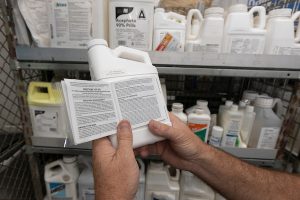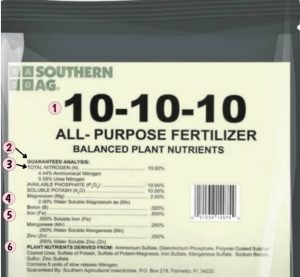Fertilizer, What Is It?
Ah, the memories of those science classes! Remember sitting there, soaking up knowledge about photosynthesis? It was like learning the ultimate life hack of the plant world – turning sunlight into food.

But wait, did your teacher delve into the world of fertilizers? You know, those nutrient boosters that often get mistaken for plant grub? The official definition is “any material, organic or inorganic, natural or synthetic, which supplies one or more of the chemical elements required for the plant growth.”
Okay, that’s a little formal. Simply put, fertilizer is not plant food (they make their food!); its plant nutrients – like sulfur, calcium, nitrogen, etc. – required for the plant to grow, develop, and reproduce. There are different sources of nutrients that plants can use. It’s sometimes hard to know what to apply since there are so many options. Let’s go a bit deeper.
Types of Fertilizer
There are two main types of fertilizers: organic and inorganic. Organic ones are naturally derived, meaning they aren’t man-made. Inorganic fertilizers, on the other hand, are the factory-made, water-soluble counterparts.
While both have their merits, it’s important not to overdo the use of either type. Applying too much, or applying them when plants aren’t actively growing, can spell trouble for both your plants and the environment. Think nutrient runoff wreaking havoc on water quality and contributing to pesky problems like algal blooms. 
Regardless of the type of fertilizer, they can do damage to plants and the environment. Luckily, the same basic principles of selection and application apply to both organic and inorganic, or synthetic, fertilizers.
Do I Need Fertilizer?
In the wild, plants get their nutrients from natural cycles. In developed areas, we use fertilizers to mimic the nutrients these cycles provide to wild plants. Developed, in this instance, refers to lawns, landscapes, and potted plants or raised beds. Fertilizers should be applied when the essential nutrients for plant growth are depleted, which is common in “developed” situations.
Fertilizers are similar in concept to a nutrient cocktail that plants use to support their growth and survival. Think of it as their vitamin regimen. The main players in this nutrient mix are nitrogen, phosphorus, and potassium – the trio responsible for keeping plants thriving. These are often referred to a macro nutrient – not because they are the most important, but they are typically required in the highest amounts when compared to the micronutrients (think calcium, iron, sulfur, etc.). Nitrogen (N) beefs up those leafy greens, phosphorus (P) digs deep for root health and flowering, while potassium (K) is like a plant’s immune system booster. Some fertilizers also contain micronutrients to support plant growth as well. Match those numbers to your plant’s needs and voila!
The Impacts of Fertilizer
But before you go wild with the fertilizer, hold your gardening gloves! Timing is everything. Just like sticking to a skincare routine, plants need a fertilizing schedule to keep them glowing. Applying fertilizers appropriately will give you the best version of your garden. Overapplication is financially wasteful and can damage your plants. The extra nutrients get washed away and enter water sources, which directly impacts public health and aquatic ecosystems, and not in a good way.
Picture this: Florida, a sunshine paradise, plagued by issues like red-tide and blue-green algae. Sound familiar? Yep, blame it on eutrophication – the fallout from excess nutrients in the water, courtesy of nutrient runoff. When aquatic plants overgrow from the nutrients in the water due to fertilizers, oxygen levels plummet, leaving marine life gasping for breath. Hence the harmful algal blooms.
Reading a Fertilizer Label
Fertilizers are regulated materials that contain plant nutrients. On the label, there must be a nutrient analysis. This analysis is the representation of the nutrients as a percentage of weight. These materials are listed on the nutrient analysis, as well as any additional nutrients. So, it is important to be able to read and understand the label to choose the right one. Let’s learn how:

- Nutrient Analysis – you can identify this by looking for the 3 numbers on the label. These numbers give the percentage of the three main nutrients, nitrogen (N), phosphorus (P), and potassium (K), by weight. So, think N-P-K when you see these 3 numbers. For example, a 100lb bag has 12-3-4, this means that there are 12lbs of N, 3 lbs. of P, and 4 lbs. of K.
- Guaranteed analysis: this is the analysis by weight of each element present in the fertilizer, warranted by the manufacturer.
- Total Nitrogen: the total amount of nitrogen expressed as a percentage.
- Additional Macro-nutrients: additional nutrients displayed as a percentage by weight of the total amount of fertilizer.
- Additional Micro-nutrients: micronutrients displayed as percentage by weight of the total amount of fertilizer. In Florida, our sandy soil may tend to have low levels of micronutrients, but your soil content should be determined by a soil test. Excess amounts of these nutrients can damage and kill plants.
- Nutrient Sources: details where the fertilizer was derived from.
Which Fertilizer Is Right for Me?
How do you know which fertilizer to pick, you ask? Start with a soil test. It’s like giving your plants a doctor’s check-up.
You can easily take a soil sample at home with a kit, or that can be sent to the UF/IFAS soil laboratory, where inexpensive testing is available to the public. Or you can pick up an online based soil test kit at your local Extension Office. Either kit is simple, provides specific instructions, and provides recommendations based on the specific plant and situation you note on the form. Based on the results, choose a fertilizer that caters to the specific nutritional needs of your plants.
Choosing the right fertilizer depends on a lot of factors. The type of plant, soil, and time of year are just a few considerations. Lawn fertilizers would burn garden plants because they contain too much nitrogen and sometimes other chemicals that are meant to control weeds, so it is important to do your research and pick the best fertilizer for your type of plant. One size does not fit all when it comes to fertilizing your plants.
Types of Fertilizer
- Complete fertilizers: this type of fertilizer contains all three of the primary macronutrients – nitrogen (N), phosphorous (P), and potassium (K).
- A balanced fertilizer contains equal amounts of nitrogen, phosphate, and potassium – like a 10-10-10 fertilizer.
- It may be beneficial to apply this type of fertilizer if your soil lacks all three nutrients, but if your soil is rich in 2, applying all 3 nutrients could burn your plants and lead to toxicity as well as waste your money!
- Incomplete fertilizer: a fertilizer that lacks one or two of the three major plant nutrients.
- Slow & Controlled release: provide nutrients to plants over an extended period of time. The idea is to save money by fertilizing less frequently and prevent excess nutrients from entering waterways.
- Read the label to find the percentage of slow – or controlled-release nutrients in the fertilizer, paying particular attention to the higher amounts of slow-release nitrogen.
- In Florida, any fertilizer that is labeled “slow-release” or “controlled-release” must contain at least 30% or more slow- or controlled-release nitrogen.
- Organic fertilizer: made from materials that are derived from plants and animals, like manure.
- Inorganic fertilizer: materials that are mined or synthesized from non-living materials.
- Dry fertilizer: made of powder or granular materials that dissolve in water.
- Water-soluble/liquid fertilizer: water soluble powders or liquid concentrates that mix with water to form a solution.
Check out Types of Fertilizer – Gardening Solutions – University of Florida for more information.
Summary
By understanding the delicate dance between photosynthesis and fertilization, you can be a gardening guru and Florida Friendly. Remember, photosynthesis is the plant’s superpower, while fertilizer is its trusty sidekick, ensuring a healthy and flourishing garden. So, next time you’re out amongst the blooms, armed with your watering can and fertilizer in hand, channel your inner botanist and let the gardening magic begin! Happy gardening, folks!
Next up, read about how to apply fertilizer!
Supervising agent: Dr. Whitney Elmore County Extension Director, Urban Horticulture Agent, and Master Gardener Coordinator
Have a question?
If you have any questions about gardening in Central Florida, please contact the UF/IFAS Extension Pasco County at 352-518-0156. For more information on UF/IFAS Extension Pasco County Community Gardens, and how you can join one, visit http://sfyl.ifas.ufl.edu/pasco/.
Follow us!
We have several ways to connect. Visit our Facebook, Instagram, Eventbrite, Blogs, Florida-Friendly Facebook, Website
More resources from UF/IFAS Extension Pasco County:
- UF/IFAS Extension Pasco County
- UF/IFAS Extension Pasco County Community Gardens
- Dr. Whitney Elmore’s Podcast: Rooted in Florida
More about fertilizer from UF/IFAS Extension:
- Soils And Fertilizers For Master Gardeners: Glossary Of Soil And Fertilizer Terms
- Fertilizing The Vegetable Garden
- Fertilization And Irrigation Needs For Florida Lawns And Landscapes
- Organic Gardening Guide
 3
3
